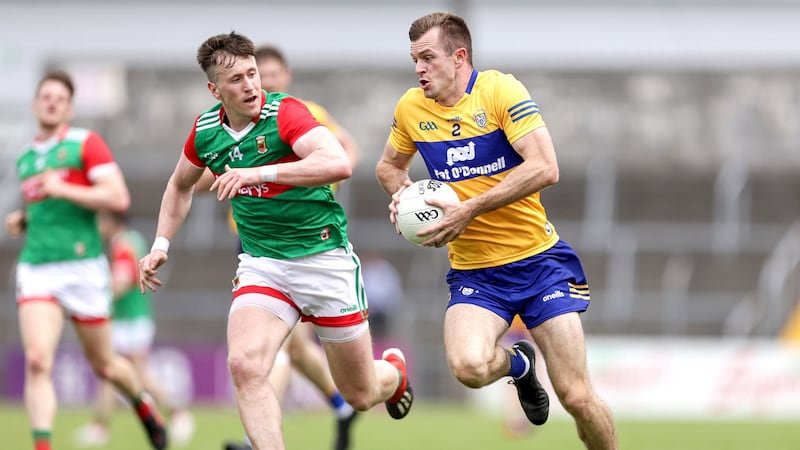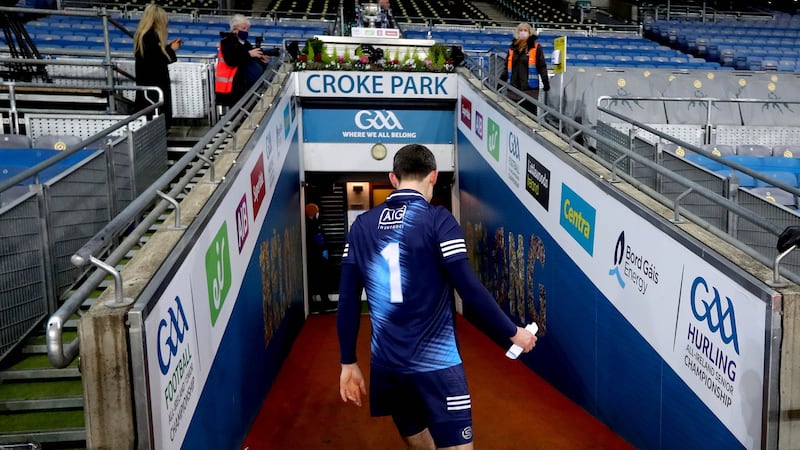A fast and furious summer beckons and I believe that Kerry will have the Sam Maguire once again when this All-Ireland championship is done.
On the surface, that sounds like a radical proposition: the end of Dublin’s dominion after seven years of splendour. But more accurately, it’s just the other side of the spinning coin we have watched through decades of All-Ireland seasons. Kerry versus Dublin is a force that is both magnificent and oppressive. I think we are about to see the pendulum swing into green and gold country.
There is a clear sense, after the strange, concertinaed league, that Kerry have closed the gap significantly on Dublin. Equally, they have moved into a different sphere than all the other contenders. They have moved ahead of Mayo, the county that bucked hardest against Dublin’s supremacy through the last decade. And they are certainly operating on a different level to Donegal and Tyrone, the would-be contenders.
So what can we expect from the 2021 All-Ireland championship? I have been involved with Gaelic football since childhood but already this year has produced one of the strangest sights I have ever encountered. It was before the Donegal-Monaghan game, itself a surreal and disconcertingly generous exhibition of scoring from both teams famous for stingy defence. Not long before throw-in, I saw the Monaghan squad walking up the main street in Ballybofey, togged into their gear, some of the players walking in socks, heading for the stands. The town was empty. It couldn’t and wouldn’t, of course, happen in normal times. They had no team bus or dressing room to use because of the Covid protocols. It was a vivid reminder that we are living through improvised times within Gaelic football. It was an arresting sight and it left me with this nagging question: can we believe what we are seeing in this league? The game itself proved to be good fun and exciting. But could we trust that it would even remotely resemble the reality of a knockout championship game between Monaghan and Donegal? I’m not sure. And I think the same was true of other games. The league was a law onto itself.
Eternal truths
Still, it did provide subtle hints of the factors which may dictate the fortunes of teams over the summer. I would argue that every year has league objectives and particularly so this year. Preserving one’s league status was crucial and because teams were coming in cold in terms of collective fitness and training - while trying to remain injury free - that became more challenging. Cavan and Tipperary provided the starkest illustration of this: luminous heroes in the depths of last winter and sliding into the fourth tier after a luckless league. Once again, the league proved what I like to think of as eternal truths. The strongest counties with the deepest resources tend to occupy the best seats in the house. So we had Kerry, Dublin, Donegal and Tyrone featuring in the semi-finals of the top tier while Mayo cantered out of Division Two. Galway and Monaghan did a few things to raise eyebrows. And we could have predicted all this before a ball was kicked in earnest.
A few trends emerged. The idea of the art of one-to-one defending is clearly disappearing. Teams are learning that they need to take out massive insurance policies. Mayo and Dublin are arguably the only teams left that trust their defenders to deal with one-and-one situations. Most teams simply do not have the defenders to deal with the quality of ball delivered to isolated attackers. Galway football people may now be starting to understand why Kevin Walsh set his teams up as he did. But we have seen all leading teams concede eye-watering totals. Mayo, for all of their lauded defensive valour, frequently cough up big scores - even their concession of 2-18 against Clare was worrying. Galway fell victim to an outrageous total against Kerry on the opening day but could feel slightly better when Tyrone did the same down in Killarney. Donegal gave four goals to Monaghan - and a hat-trick to Conor McCarthy - in that Ballybofey game. Teams won’t - and can’t - give up those kind of numbers in knockout championship games. So it is likely that systemic, zonal defending will be the order of the day.
Statistics on penalty conversions since the new rules brought the ball in to 11 metres from the goal rather than the old 13 metre distance make for interesting reading
And big question marks loom over the availability and health of marquee players. We haven’t seen Michael Murphy, Donegal’s eternal talisman, since early in that Monaghan game. If he is not at full health, then Donegal’s visit to Down next Sunday becomes a much more dangerous assignment. We know Cillian O’Connor is goosed and he is simply irreplaceable for Mayo. We haven’t seen Stephen Cluxton in the Dublin goal yet. This is not the usual form. He hasn’t played a minute since the All-Ireland final and while Leinster should provide a smooth launching pad, it is still a very unusual situation. Could it be that arguably the most influential player in the history of the game has just silently slipped out of the picture? It would be a stunning and entirely characteristic exit. Darragh Canavan’s injury is a significant dent in the Tyrone project. Galway’s Shane Walsh looked to be in bother after the Monaghan game. These were not illusions. These injuries were the result of a shortened league and limited training.

Black cards have become true turning points in games. It is now a punishment that truly hurts the team: the loss of a player for 10 minutes. Once you go to 14 - or 13 - men you are immediately forced into changing strategy. You cannot push up on a kick out. Your attacking strategy collapses completely. You are basically trying to kill 10 minutes of time and limit the damage on the scoreboard. But even if you do that, you are expending extra energy and it catches up with you eventually. The black card predicament provides an added complication for the manager. The water breaks also have to be used prudently. They were introduced as a Covid precaution and, because the virus is still around us, there is no talk about removing them. And they are essentially tactical breaks now. They are de facto time-outs. They have to be exploited.
So the manager’s workload on the line has never been heavier. You have seven substitutes to be filtered in over five opportunities. There is no Maor Foirne to share the burden. There are new rules to work on - the kick out, the cynical foul, the new advantage rule. And while the offensive mark has not had a major influence yet, I believe it could change the outcome of a few championship games this summer. I don’t like it: it brings nothing to the game. But it could have a major impact if teams decide to exploit it and build an offence around it.
Stick of dynamite
Funnily, the early furore over the penalty foul didn’t really feature in subsequent rounds of the league. But it still lurks as a stick of dynamite. An attack, a rash pull down by a defender and a sudden black card and penalty: it could have a massive bearing on a knockout game. So coaches and managers have to look at those last-gasp fouls in a completely new light. The statistics on penalty conversions since the new rules brought the ball in to 11 metres from the goal rather than the old 13 metre distance make for interesting reading. It used to be little better than 50-50. Right now, my sense is that eight out of 10 penalties are converted. So a defender is probably better off giving the attacker the live shot.

I remember speaking with Tomás Ó Sé about this and he agreed in theory but pointed out that the defenders’ instinct will be to prevent the shot at all costs. Still, the cuter play is to stay disciplined and make the attacker take his goal from play if he has it in him. Unless that attacker is David Clifford! Kerry’s stock and hopes have soared on the back of his supernova league form. There is a black joke in Kerry that Colm Cooper destroyed a generation of Kerry defenders because every kid wanted to play number 13. Imagine the impact Clifford must be having on Kerry’s future generations.
The criticism within the county last winter was probably pointed but nobody will have been more critical than the squad and management
Clifford is the leading reason why Kerry believe this is their year. Look at the raw scoring numbers. It is obvious you have to reach 20 scores to beat Dublin in an All-Ireland championship game. A few years back, 1-14 would win a lot of games. That just keeps you in contention nowadays. Where does this 1-19 or 2-18 come from? It’s that old A.S.S (Attacks. Shots. Scores) number: 40 attacks: 30 shots: 20 scores. Many teams aspire to that but Dublin routinely achieve it. It’s just 66 percent accuracy but they can exceed that because their shot selection is of such high quality. And many teams simply can’t generate that number of attacks - particularly against Dublin.
The league has shown that Dublin can be aggressive high up the pitch and they are quite judicious in their use of that pressing tactic. For instance, they will use a free kick to get set up to pressurise the subsequent kick out. And when the opposition have scored, they are fantastic at going short to restart their attack and kill opposition momentum. They rarely allow a team to get a flow of scores. They are so big and athletic that when they push up the space on that field disappears.
Kerry have the depth and firepower to match Dublin. And I don’t feel Dublin are quite as good as they were three seasons ago. When Brian Fenton was at his absolute peak in 2018 and 2019, they were unstoppable. I am not sure they are improving as a force. They are unreal in their energy and hunger and enthusiasm to prolong this extraordinary winning streak. But we are dealing with the human condition. The motivation within Kerry is of a different scale. The criticism within the county last winter was probably pointed but nobody will have been more critical than the squad and management. They know. There has been a sense of vengefulness and atonement in how they have attacked the league. I expect that to continue in the championship. They are ready to win it all now. And given the culture of fanaticism that fuels the Kerry tradition, they have to win it all now.
















